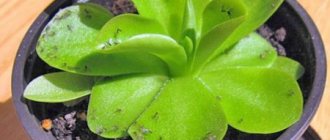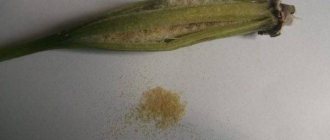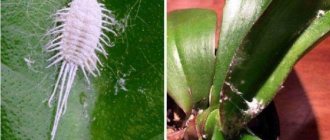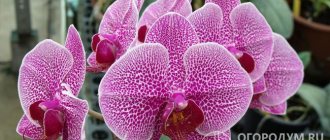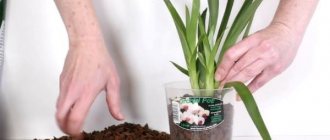Quote from message Galina5819
Read in full In your quotation book or community!
Has the orchid's roots rotted? - No problem! I'll tell you how to save an orchid without roots! We fertilize the onions... with ammonia. A drop of iodine - and you won’t recognize your geranium. How to prune geraniums correctly so that they bloom magnificently! Link General rules for caring for an orchid Drink aphids to death with Coca-Cola Three recipes for feeding geraniums 555 “Green” fertilizer from nettles Fertilizing house flowers Onion peels are a treasure for summer residents Plants guard against pests Growing garlic: according to mother’s recipe Follow these 9 rules and yours The orchid will bloom all year round! Treat the ant queen with boric acid and the villains will leave your area Soda and powdered sugar - a new tool in the fight against ants Several options for good fertilizers for indoor flowers Shaping currants with a tree I water my violets using... tights It turns out that geranium likes to drink mash When and how to replant an orchid at home conditions: terms and rules Unusual feeding for indoor flowers White geranium - for procreation, pink - for love How to turn one orchid into a hundred? Three simple flower tricks. Cinnamon against mold and midges 555 Why geranium leaves turn yellow and dry.
What to do?!
If the roots of an orchid have rotted, do not rush to panic, much less throw away the plant, I will tell you how to save an orchid without roots. This is perhaps the most common problem among both established flower growers and beginners. Therefore, the plant is considered capricious, and many are afraid to place this beauty in their apartment. In fact, it is difficult to find a houseplant more resilient than the orchid. The main thing is to find the right approach to it, then the orchid will delight the eye with its blooms for many years.
The orchid's roots have rotted, what should I do?
Even if your flower is left completely without roots, do not rush to bury the plant alive; most often such specimens are simply thrown away, having come to terms with the fact that care is too difficult and was beyond their ability. When an orchid's roots have completely rotted, it can still be saved!
First you need to cut off all the rot from the plant. Don’t be afraid to cut to the quick; it is this common mistake that prevents the plant from being revived; if areas damaged by rot remain on it, they will spread further and lead to the death of the orchid. The scissors that will be used for processing must be disinfected: dip them in boiling water, ignite them over a fire, wipe them with alcohol or another disinfectant. Make sure there are no rotten areas left on the plant. In this procedure, it is important to be merciless, there is no need to spare the plant - cut everything, even if at the end of the procedure you only have one growing point with leaves in your hands.
After this, begin processing the “patient”. There is an opinion that you can lubricate the cuts with brilliant green, but I do not agree, since brilliant green, due to its properties, dries out the treated areas greatly, so it is better to take activated carbon. It must be crushed and lubricated on the cuts (ATTENTION! Do not sprinkle, but rather lubricate). Now you can leave the orchid alone for several days (2-3 days will be enough). Experienced flower growers recommend making a greenhouse for such reanimated plants, but due to lack of time and desire to tinker with it for a long time, I left the orha in an empty pot.
Use against diseases and pests
I plan to use glucose and or sugar to resuscitate a sick orchid, remember that this is not a medicine, but a supportive and restorative agent. Lotions are made from it. The procedure is similar to wiping the leaves. A cloth soaked in a glucose (or sugar) solution is applied to the leaf plates, wrapping them. Press lightly and leave for several minutes.
Lotions are required for leaves affected by diseases and pests. But, it is advisable to wipe and wrap all the plates so that the infection does not spread to healthy tissue. After such treatment, a thin nutrient film is formed, which prevents the spread of pathogens and repels pests.
After this procedure, it is better to spray no earlier than a month later.
How to save a rootless orchid using foliar feeding?
A few days later, still not knowing how to save an orchid without roots, and whether it was possible in principle, I began to spray it with “Doctor Foley Orchid” foliar fertilizer, and the cutting itself (the place where I was looking forward to the appearance of new roots) was simply sprayed with regular water from a spray bottle. And this lasted for about six months... Yes, yes, don’t think that in a week there will be wild flowering on your windowsill and the orchid will feel great. The orchid's roots have rotted, it is not as easy as it seems, but it does not give up and clings to life with its last leaves.
Where to buy
Buying a sweet remedy is not a problem. It is sold in every pharmacy in tablets.
Glucose tablets are sold in pharmacies.
In addition, it is produced in liquid form in bottles or ampoules.
Glucose is sold not only in pharmacies. It is available in grocery stores and supermarkets, in confectionery departments. There it can be purchased under the names:
- “Confectionery glucose” in the form of a snow-white fine-crystalline powder,
- "Glucose syrup" looks like a viscous transparent liquid,
- “Glucose molasses” is a thick amber-colored mass.
Each species is quite suitable for feeding orchids.
Conditions for keeping an orchid
Properly organized care involves creating conditions close to natural. An orchid will remain healthy and decorative for a long time if:
- all the flower’s needs for nutrition, lighting and watering are taken into account and provided;
- the plant is satisfied with the temperature and humidity conditions, the composition of the soil and the applied fertilizers.
When choosing a flower for home growing, you need to remember that orchids have many varieties, differing in appearance, natural growing conditions, and needs.
Without leaving this fact unattended, you can significantly simplify the care of orchids for beginners and for flower growers who already know a lot about the maintenance of this crop.
Most of the plants found in interiors are epiphytes that arrived from the tropics. They are easily recognized by their succulent aerial rhizomes, which not only provide the flower with moisture and nutrition, but also take part in the process of photosynthesis. There are orchids that are accustomed to living on rocks, where the soil layer, like on trees, is extremely small.
For such plants, air humidity and looseness of the substrate are important. But soil-based species, in addition to the usual orchid care, also need nutritious soil.
What substances are needed
For the normal development of an orchid and its long, abundant flowering, many minerals are needed. Next, we will consider those substances whose presence in feeding is absolutely necessary.
Nitrogen
This element is an essential component of all protein and other organic compounds in plant tissues. The main function of nitrogen is to launch the intensive process of photosynthesis, which affects all life processes, primarily the formation of lush green mass.
If the orchid does not have enough nitrogen, it will react to this fact by shredding, turning pale leaves, losing a fair amount of decorativeness, drooping, weakening the stem, and stopping development.
Potassium
This mineral is responsible for carbon metabolism in plant tissues, and in general for the health of the flower. Potassium directly affects the formation of flower buds, so the use of the mineral is extremely important for lush flowering. Potassium is also necessary for cellular water exchange. This mineral increases the orchid’s immunity and resistance to various diseases and misfortunes.
If an orchid experiences a lack of potassium, this will manifest itself in the form of too small buds and a small number of them. In addition, the duration of flowering will become significantly shorter. Due to the lack of potassium, by the way, nitrogen cannot be fully absorbed.
Phosphorus
The orchid needs the mineral for the correct and active development of roots, as well as for the complete transmission of all important varietal genetic characteristics to the offspring. Phosphorus is also indispensable in the processes of flowering and plant reproduction. If an orchid is critically short of phosphorus, it may even die; in milder cases, it weakens and withers.
Magnesium and boron
Microelements necessary for normal energy metabolism. With their shortage, the growing season noticeably slows down, which greatly affects the development and flowering of the orchid. It is likely that the buds will dry out, flowering will stop completely, and even the growing points will die off.
Sulfur and iron
A lack of these minerals is likely to lead to yellowing of the foliage - so-called chlorosis. Orchid leaves affected by chlorosis become much less decorative, take on a sickly appearance, and wither. In severe cases, the foliage dries out and dies.
In addition to the minerals already listed, in smaller quantities, but nevertheless, the following substances are also needed:
- zinc;
- manganese;
- chlorine.
Make sure that they are present in the complex fertilizer.
Lighting Features
In the tropics, where the vast majority of indoor species come from, orchids grow in conditions of long daylight hours and moderately bright, diffuse lighting. The same conditions are recreated in a situation where the orchid is cared for at home.
The optimal duration of daylight hours for actively growing and flowering orchids is 13–15 hours, practically not decreasing in winter. Therefore, additional lighting will not be superfluous when caring for an orchid.
You should not place pots on south-facing windows without well-thought-out shading. Bright sunlight can leave brown or yellow marks on the foliage, and buds in direct hot rays may even fall off. The best place is the east or west side. On northern windows, lighting will be required even in summer.
If the place for the plant is chosen incorrectly, even with proper care at home, the orchids, as in the photo, turn yellow, their leaves lose their elasticity, dry out, flowering becomes rare or does not occur at all.
Why is it necessary to apply fertilizer only during the growth period?
Fertilizing should be applied only during the growth period, otherwise the fertilizer will not benefit the plant.
It makes no sense to feed a flower when it is in the dormant stage, and in some cases it is even dangerous - by introducing various means at the wrong time, you can activate the growth of phalaenopsis in an unnatural period for it. And frequent application of fertilizing will result in excessive leaf growth instead of the expected intensive flowering.
Moisture in the air: the key to success in caring for an orchid at home
Increased air humidity is extremely important for the successful cultivation of tropical plants. And if in the summer it is quite possible to achieve the desired 60–70%, then in the winter the gardener will have to try.
How to properly care for an orchid when heating devices are running, mercilessly drying the air in the room? To maintain such air humidity, electric humidifiers and household products are used.
The container in which the flowers are grown can be placed on damp moss placed in a shallow tray. If you don’t have sphagnum moss on hand that retains moisture for a long time, expanded clay is used in the same way. The plants feel best in a florarium or indoor greenhouse, separated from the rest of the room by plastic or glass.
When a florist uses foliage spraying for care, this should be done regularly and carefully, trying not to get it on the flowers. It is extremely undesirable to allow a still wet orchid to cool, as this will lead to the development of fungus on the succulent leaves and aerial roots.
The flower should be irrigated in the first half of the day with water at room temperature, until the foliage is dry; the pot should be protected in every possible way from cold air and drafts.
Useful video
From the video you will learn how to water an orchid to prevent rotting:
If you find an error, please select a piece of text and press Ctrl+Enter.
“Grows by leaps and bounds” - this old saying is also true for plants. However, not every plant, or rather the substrate in which it lives, is suitable for feeding with yeast.
So, is it possible to water an orchid with yeast and how to do it correctly - read this article. Because mistakes, as a result of misunderstanding of the material, can simply reduce all your efforts to nothing.
Watering when caring for an orchid in a pot
When studying information on how to care for an orchid at home, a novice gardener should not ignore the issue of watering these natives of the tropics.
The appearance of a plant alone can tell a lot about its preferences and needs. Powerful aerial and underground rhizomes are designed to obtain and store moisture. In addition, the flower can save a certain amount of nutrients and water in the leaves, which are noticeably thicker in some species.
All orchids are moisture-loving and require abundant watering, in which the soil ball or loose coarse-grained substrate poured into the pot is completely wet.
But how to care for an orchid at different times of the year? Does the frequency of watering change, and how can you find out about the “thirst” of a flower located in a mixture of bark, expanded clay, pieces of foam plastic and other materials that bear little resemblance to traditional soil?
The watering schedule, as well as other orchid care procedures, must be adjusted when the season changes. In the warm season, a potted orchid receives water more often than in winter. But it is better to underwater the plant than to overwater it.
Thick leaves and roots will help the orchid survive short-term drought, but excess moisture, and especially its stagnation, is a sure step towards rotting of the roots.
Tropical guests at home are planted in transparent plastic pots or containers with special slots. This makes it possible to monitor the condition of the root system; the rhizomes themselves participate in photosynthesis and more easily consume nutrients and moisture. But how to care for an orchid in a pot of such an unusual design?
There are no special features of caring for an orchid, except that you have to water a flower in a solid container from above, and it is convenient to immerse pots with slots in prepared water for 4–6 minutes. During this time, the substrate will be saturated with moisture, and the excess will drain freely.
In summer, the substrate is moistened 2-3 times a week, when the surface of the soil feels dry to the touch. In the cold season, the frequency of watering is sharply reduced.
The need for water is recognized by rhizomes that have lost their elasticity, slightly shriveled and drooping leaves. A healthy plant quickly recovers after moistening the soil.
But limp foliage on regularly watered orchids should alert the gardener. Perhaps the roots were once flooded and now need sanitization.
How to feed the plant so that it blooms blue?
How can you treat an orchid to make it blue? Need to remember! There are no blue orchids! If one is sold in a store, then it is most likely white, simply painted with a chemical dye that will wash off over time.
For the first time, blue phalaenopsis was presented at an exhibition in the USA in 2011. Then, a few months later in Holland, the famous nursery "Geest Orchideeën" presented to the public Phalaenopsis Royal Blue, colored using a patented technology.
This dye is natural and does not harm the plant. The secret of this technology is not disclosed. But many sellers, wanting to make good money and not caring about the health of the orchid, try to paint it the desired color without any technology. Most often this is simply an injection of ink or blue into the stem or root of a plant. After purchasing the orchid, it may simply die.
Japanese breeders have bred the only truly blue species of orchid by introducing the blue-eyed gene, but, unfortunately, it is not commercially available.
If you still really want to try “coloring”, it is better to use food coloring. Dissolve the paint in water for irrigation. The richer the color of the water, the brighter the color of the plant. The procedure is simple, but not very effective and not durable.
If you stop watering the dye, the orchid will return to its original color. Flower growers recommend using water in which aluminum alum was soaked for safe coloring. The injection is more effective, but the damage to the plant is enormous. Most likely it will get sick and require constant care.
Feeding indoor orchids
Like other indoor crops that are forced to grow in a limited volume of substrate, orchids need regular feeding. But these plants should not be fertilized too often. It is optimal if specialized liquid formulations are applied no more than twice a month and only during the period of active growth and flowering.
An increased salt content in the soil negatively affects the condition of the plant. How to care for an orchid if there are traces of salinity on the surface of the filler in the pot? It is better not to fight this phenomenon, but to prevent its occurrence. Therefore, feeding is alternated with washing the root system, for which the pot is immersed in warm, soft water for several minutes.
If the fertilizing included in the care of an orchid is excessive, the flower tolerates temperature changes less well and is also more often affected by pests and fungi.
Ash as a fertilizer: chemical composition
Ash is indeed a valuable source of mineral elements necessary for the normal development of plants. Wood ash is most often used in crop production, which has the following chemical composition:
| Mineral elements | Contents in ash |
| Calcium | 30-35% |
| Potassium | 6-10% |
| Phosphorus | 2,5-3,5% |
The ash prepared from deciduous wood contains more potassium and phosphorus, while the ash of coniferous wood contains calcium carbonate. In addition to the main elements listed in the table, wood ash contains small amounts of magnesium and sodium, as well as traces of iron, sulfur, silicon, etc.
Nitrogen is completely absent in the ash, since all organic matter built with the participation of this element burns completely. Based on this, ash should be classified as mineral fertilizers, and not organic.
Important! The large amount of calcium carbonate in the ash gives it alkaline properties. Ash greatly affects the acidity of soils, shifting the pH to the alkaline side, therefore it is widely used as a deoxidizer. Therefore, before using this product, it is necessary to check the acidity of the substrate. If it is close to neutral, you cannot use ash fertilizers.
Pine bark, in which indoor orchids are most often grown, acidifies the substrate when decomposing. Orchids love slightly acidic soils with a pH value of 5.5-6.0. In a highly decomposed substrate, this indicator is much lower (about 4). Therefore, ash fertilizers in such a situation can help the orchid survive until transplantation.
Basic rules of application
- All fertilizing is applied only to the wet root system of the plant, so as not to burn the roots;
- All nutrient solutions must be diluted in small proportions ;
- Water used in solutions must be warm and settled ;
- Fertilizer applied for the first time is used on one plant or half a leaf . This is done to ensure that the flower is not immediately harmed by the incorrect concentration of the solution.


